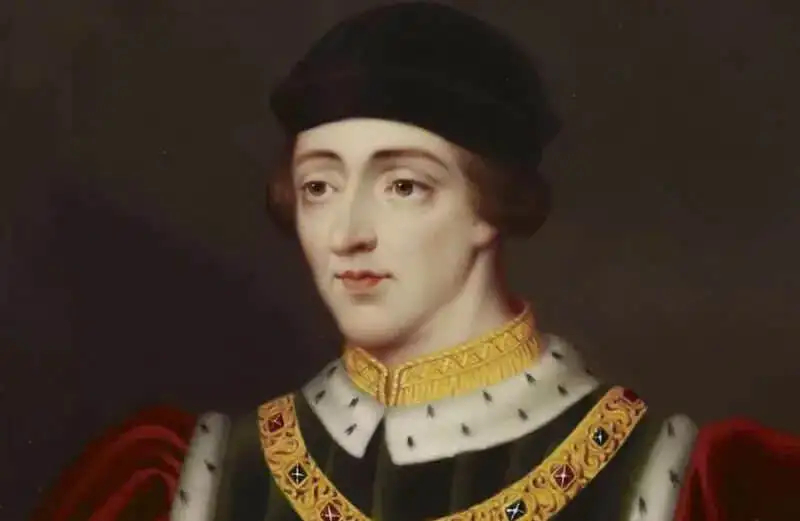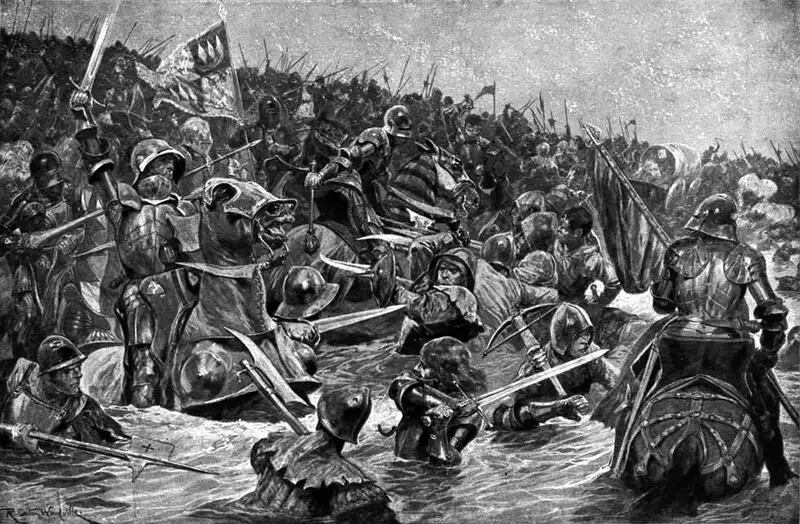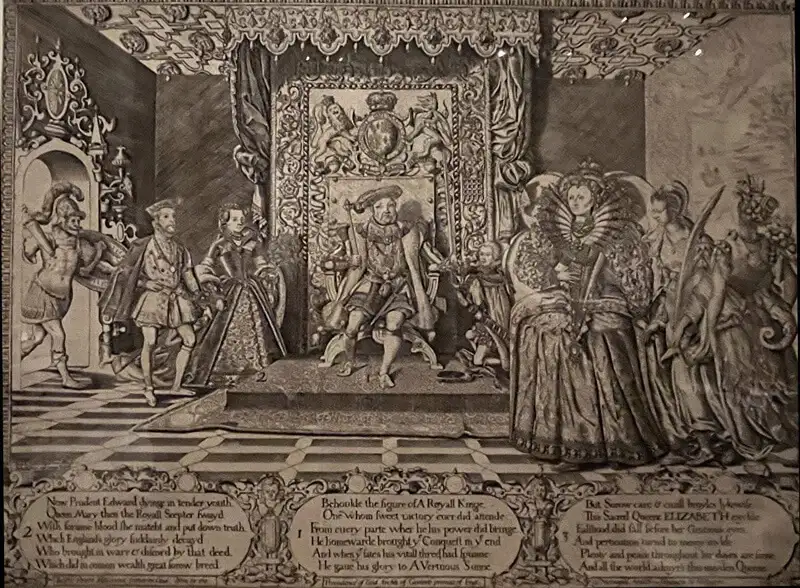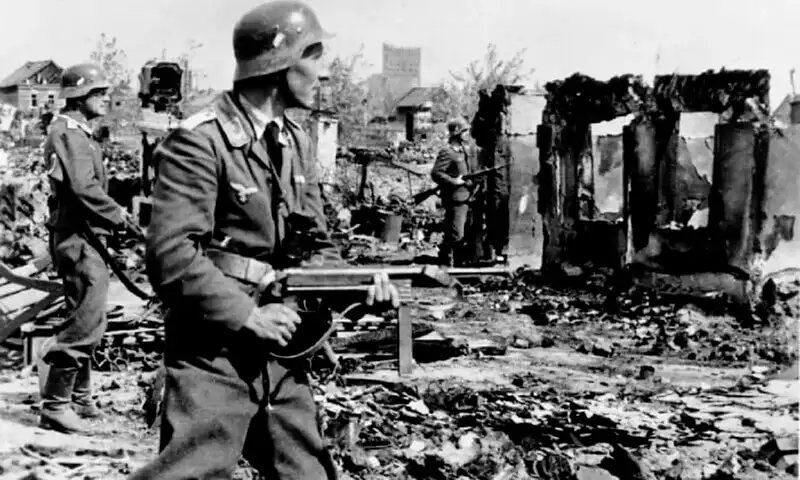The Wars of the Roses were a succession of brutal civil wars fought over the English throne between two opposing royal dynasties: House York and House Lancaster. Both were branches of the longstanding Plantagenet royal family. The conflicts spanned from 1455 to 1485 and earned the name “Wars of the Roses” due to the symbols of the two houses—House York represented by a white rose and House Lancaster by a red rose. After 30 years marked by political machinations, devastating destruction, and brief periods of peace, the wars concluded with the emergence of a new royal dynasty.
King Henry VI
In 1422, Henry VI ascended to the English throne at just nine months old, succeeding his father, Henry V.
Thanks to his father’s military conquests, Henry VI also became a contested claimant to the French throne. In 1445, Henry VI married Margaret of Anjou, an ambitious and politically astute Frenchwoman who wielded far greater influence than the king himself.
However, Henry VI’s court was far from stable. He showed little interest in politics and was regarded as a weak ruler, which led to widespread lawlessness throughout the kingdom. This instability provided fertile ground for ambitious nobles and power-hungry manipulators to conspire against him.

Richard of York
Henry VI’s lack of leadership resulted in the near-total loss of English territories in France. Coupled with corruption, poor governance, and burdensome taxation, this sparked a rebellion in 1450 among discontented peasants and landowners from Kent.
Led by Jack Cade, they marched on London and presented a list of demands titled “The Complaint of the Poor Commons of Kent” to Henry.
Though he did not officially agree to their demands, Henry was compelled to recall Richard of York from Ireland to England. A great-grandson of King Edward III, Richard of York had a strong claim to the English throne.
After a series of clashes, Henry suppressed Cade’s rebellion and pardoned the rebels—except for Jack Cade, who later died of fatal wounds sustained during his capture.
Henry believed Richard of York was behind the uprising (though there was little evidence to suggest his involvement). This rivalry set the stage for 30 years of power struggles between the York and Lancaster dynasties.
The Madness of King Henry VI
By 1452, Richard of York had returned to England with the goal of removing Henry’s corrupt advisors, particularly Edmund Beaufort, Duke of Somerset. Richard raised an army and marched on London, pledging loyalty to Henry while demanding Somerset’s dismissal.
However, Somerset retained his position until Henry suffered his first bout of madness in 1454, rendering him nearly incapacitated and unable to rule.
During Henry’s illness, Richard was appointed Lord Protector of England and ordered Somerset’s imprisonment in the Tower of London. Yet this victory was incomplete: in 1453, Queen Margaret gave birth to Edward of Lancaster, Henry’s only son, weakening Richard’s claim to the throne.
In February 1455, Henry unexpectedly recovered from his madness. Richard and his ministers were ousted from court, while Somerset was restored to his position.
The Battle of St. Albans
On May 22, 1455, Richard of York, allied with Richard Neville, Earl of Warwick, marched against Henry at St. Albans. After failed negotiations, a short but brutal battle erupted in the town’s streets, resulting in Somerset’s death and Henry sustaining injuries.
House York captured Henry, and Richard was once again named Lord Protector. Meanwhile, Queen Margaret and her young son were forced to flee to safety.

> You might also be interested in: The Hundred Years’ War: A Fierce Conflict Between England and France
The Battle of Blore Heath
As Richard held power precariously in England, Queen Margaret quietly worked to restore the throne to Henry and secure her son’s inheritance. Fearing his time was running out, Richard assembled an army under the command of Lord Salisbury.
Salisbury’s forces clashed with Margaret’s larger, well-equipped army, led by Lord Audley, at Blore Heath in Staffordshire on September 23, 1459. Despite being outnumbered two to one, the Yorkists achieved a resounding victory over the Lancastrians.
The Battles of Ludford Bridge and Northampton
The Battle of Ludford Bridge was not fought with weapons but was a test of will and courage. By the autumn of 1459, Henry VI and Queen Margaret had once again amassed a large army, bolstered by defectors from the Yorkist ranks.
Richard of York, Salisbury, Warwick, and their forces retreated to Ludlow Bridge near Ludford, Shropshire, to face Henry’s army. However, on the night of October 12, many Yorkist soldiers deserted, forcing their leaders to flee; Richard himself escaped to Ireland.
Yet Richard and his allies did not abandon their fight against Henry and Margaret. In June 1460, Richard’s ally Warwick entered London with thousands of troops. When they confronted Henry’s forces at Northampton, victory seemed unlikely.
Unexpectedly, a Lancastrian commander betrayed his side, allowing Warwick’s forces to breach Henry’s camp. The Yorkists secured an easy victory, capturing Henry, while Queen Margaret was forced to flee once more.
The Battle of Wakefield
With Henry VI under their control, Richard of York declared himself and his descendants as Henry’s successors. Henry agreed, on the condition that he retain the crown until his death.
This agreement was ratified by the English Parliament as the Act of Accord. However, the ambitious Queen Margaret rejected the compromise and instead raised a new army to oppose the Yorkists.
Richard led his forces to confront Margaret’s army, intent on settling the succession once and for all. The two sides clashed at Wakefield Green near Sandal Castle. However, events did not unfold as Richard had planned. He was killed in battle, and his severed head was displayed with a paper crown as a mocking symbol.
The Battle of Towton
Following Richard’s death, his son Edward, Earl of March, succeeded him and continued the fight against the Lancastrians.
In the winter of 1461, Edward led the Yorkist forces to victory over the Lancastrians at the Battle of Mortimer’s Cross. However, weeks later, the Yorkists suffered a crushing defeat at the Second Battle of St. Albans, where King Henry VI was rescued and reunited with Queen Margaret. Yet Edward pressed on.
In March 1461, Edward faced the Lancastrians in a snowstorm on a field near Towton, North Yorkshire. Over 50,000 soldiers are believed to have fought in this ferocious battle, with approximately 28,000 lives lost.
The Battle of Towton is regarded as the bloodiest single-day conflict in English history. The Yorkists emerged victorious, forcing Henry VI, Margaret, and their son to flee to Scotland. Edward ascended the English throne as king.

Shifting Power
Though Edward IV claimed the throne, he underestimated the resolve and ambition of the deposed Queen Margaret. With support from allies in France, Margaret overthrew Edward and restored her husband, Henry VI, to the throne in October 1470.
Edward refused to yield. After going into hiding, he rallied an army and triumphed in the battles of Barnet and Tewkesbury. At Tewkesbury, Henry and Margaret’s only son was killed, and the royal couple was imprisoned in the Tower of London. The English throne was then returned to Edward IV.
On May 21, 1471, Henry VI died, reportedly of grief, though some historians suggest he was murdered by Edward. Queen Margaret was later released and returned to Anjou, France, where she died in 1482.
The Princes in the Tower
King Edward IV died in 1483, and the throne passed to his young son, Edward V. Richard III, Edward IV’s ambitious brother, was appointed Lord Protector for his nephew. However, he schemed to declare Edward V and his brother illegitimate to seize the crown.
Richard III succeeded in his plan and was crowned king in July 1483.
To eliminate threats to his power, Richard imprisoned his two nephews in the Tower of London, ostensibly for their protection. However, when the boys—now known as the Princes in the Tower—disappeared, Richard was accused of ordering their murder, quickly losing the trust of his subjects.
The Tudors
As Richard III’s power weakened, Henry Tudor of the Lancastrian faction, backed by France and numerous nobles, asserted his claim to the throne. The confrontation between Henry and Richard took place at the Battle of Bosworth on August 22, 1485.
After a fierce battle, Richard III was killed. Legend has it that his crown was placed on Henry’s head at the spot where Richard fell. Henry was proclaimed King Henry VII.
Following his formal coronation, Henry married Elizabeth of York, uniting the long-feuding houses of Lancaster and York. This marriage ended the Wars of the Roses and ushered in the Tudor dynasty.

> See also: The Battle of Agincourt: A Pivotal Victory in the Hundred Years’ War
Conclusion
Through this overview of the Wars of the Roses, Pywar hopes to have provided you with a comprehensive look at the tumultuous chain of events in English history. From the power struggle between House York and House Lancaster to the ferocious battles of St. Albans, Wakefield, and Towton, these wars reshaped the political landscape and led to the rise of the Tudor dynasty. We hope this article deepens your understanding of the figures and events that shaped history during one of its most dramatic chapters.
Translated by: Le Tuan
Source: history.com – Wars of the Roses



